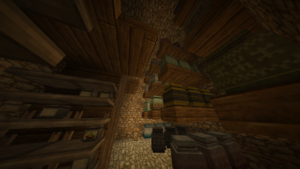Cellar/en: Difference between revisions
(Updating to match new version of source page) |
(Updating to match new version of source page) |
||
| Line 1: | Line 1: | ||
<languages/>{{GameVersion|1.16.4}} | <languages/> | ||
{{GameVersion|1.16.4}} | |||
[[File:Cellar-example.png|thumb|right|An example of a player-made cellar.]] | |||
'''Cellars''' are a type of structure players may create, for the purpose of [[food preservation]] and ripening [[cheese]]. The impact of cellars is more obvious in warmer biomes. | '''Cellars''' are a type of structure players may create, for the purpose of [[food preservation]] and ripening [[cheese]]. The impact of cellars is more obvious in warmer biomes. | ||
| Line 16: | Line 18: | ||
The main use of cellars is for food preservation. Cellars reduce the rate of spoilage for any foods stored inside, and stack with container types, so placing storage containers and sealed crocks into a cellar can drastically extend the shelf-life of any food inside them. Cellar effects are strongest on grains, vegetables and fruits. | The main use of cellars is for food preservation. Cellars reduce the rate of spoilage for any foods stored inside, and stack with container types, so placing storage containers and sealed crocks into a cellar can drastically extend the shelf-life of any food inside them. Cellar effects are strongest on grains, vegetables and fruits. | ||
Cellars are also used to ripen cheese by lowering their spoilage timer, so that the cheese can ripen before it spoils. Cheese may ripen into either cheddar or blue cheese, depending on the conditions of the ripening cellar. Cheddar has no special requirements, while blue cheese requires a cellar with unblocked access to air ''and'' a sunlight level below 2. | Cellars are also used to ripen cheese by lowering their spoilage timer, so that the cheese can ripen before it spoils. Cheese may ripen into either cheddar or blue cheese, depending on the conditions of the ripening cellar. Cheddar has no special requirements, while blue cheese requires a cellar with unblocked access to air ''and'' a sunlight level below 2. <!--MISSING: Step by step info on how to make a cellar that is suitable for blue cheese.--> | ||
{{tnt|Farming navbox}} | {{tnt|Farming navbox}} | ||
[[Category:Structures{{#translation:}}]] | [[Category:Structures{{#translation:}}]] | ||
Revision as of 15:00, 12 July 2022
This page was last verified for Vintage Story version 1.16.4.
Cellars are a type of structure players may create, for the purpose of food preservation and ripening cheese. The impact of cellars is more obvious in warmer biomes.
Protip:
Cellar spoilage rates update with a delay. To get accurate information after modifying a cellar, place down a new container or shelf in the space, and see what the new rate of spoilage is. |
Creation
Any fully-enclosed room at or under 7x7x7 blocks in size may be counted as a cellar by the game. While wooden doors count for enclosing cellars, rough doors do not. Cellars do not need to be underground to work, however since sunlight levels can affect cellar effectiveness, it may be easier to dig an underground cellar than to create an aboveground one. Any blocks may be used to create a cellar, however for maximum effectiveness dirt, brick and stone blocks (such as packed dirt or cobblestone) should be used. The higher the outside temperature is, the more the building material matters. Mixing material types will reduce the effectiveness of the cellar depending on how much non-dirt, non-stone or non-brick blocks are used.
Light restriction
Sunlight reaching the cellar can reduce the effect of cellars, as well as having an impact on cheese ripening. Transparent blocks such as glass or doors, which may let in light, will reduce the effectiveness of cellars. Therefore, it is recommended to seal up cellars using blocks like dirt or hay, or to include a sharp bend in the hallway leading to the cellar to prevent sunlight from reaching inside the room.
Player-created light sources, such as torches and lanterns, have no impact on cellar effectiveness.
Uses
The main use of cellars is for food preservation. Cellars reduce the rate of spoilage for any foods stored inside, and stack with container types, so placing storage containers and sealed crocks into a cellar can drastically extend the shelf-life of any food inside them. Cellar effects are strongest on grains, vegetables and fruits.
Cellars are also used to ripen cheese by lowering their spoilage timer, so that the cheese can ripen before it spoils. Cheese may ripen into either cheddar or blue cheese, depending on the conditions of the ripening cellar. Cheddar has no special requirements, while blue cheese requires a cellar with unblocked access to air and a sunlight level below 2.
| Farming | |
|---|---|
| Wild foods | Berries • Cactus (saguaro) fruit • Mushrooms • Cattail (and papyrus) |
| Grains | Amaranth • Cassava • Flax • Rice • Rye • Spelt • Sunflower |
| Vegetables | Cabbage • Carrot • Onion • Turnip • Parsnip • Peanut • Pumpkin • Soybean |
| Fruits | Fruit trees • Pineapple |
| Other | Fertilizer • Beekeeping • Room |
| Tools | Hoe • Scythe • Fruit press |
| See also | Animal husbandry • Cooking • Food preservation |
